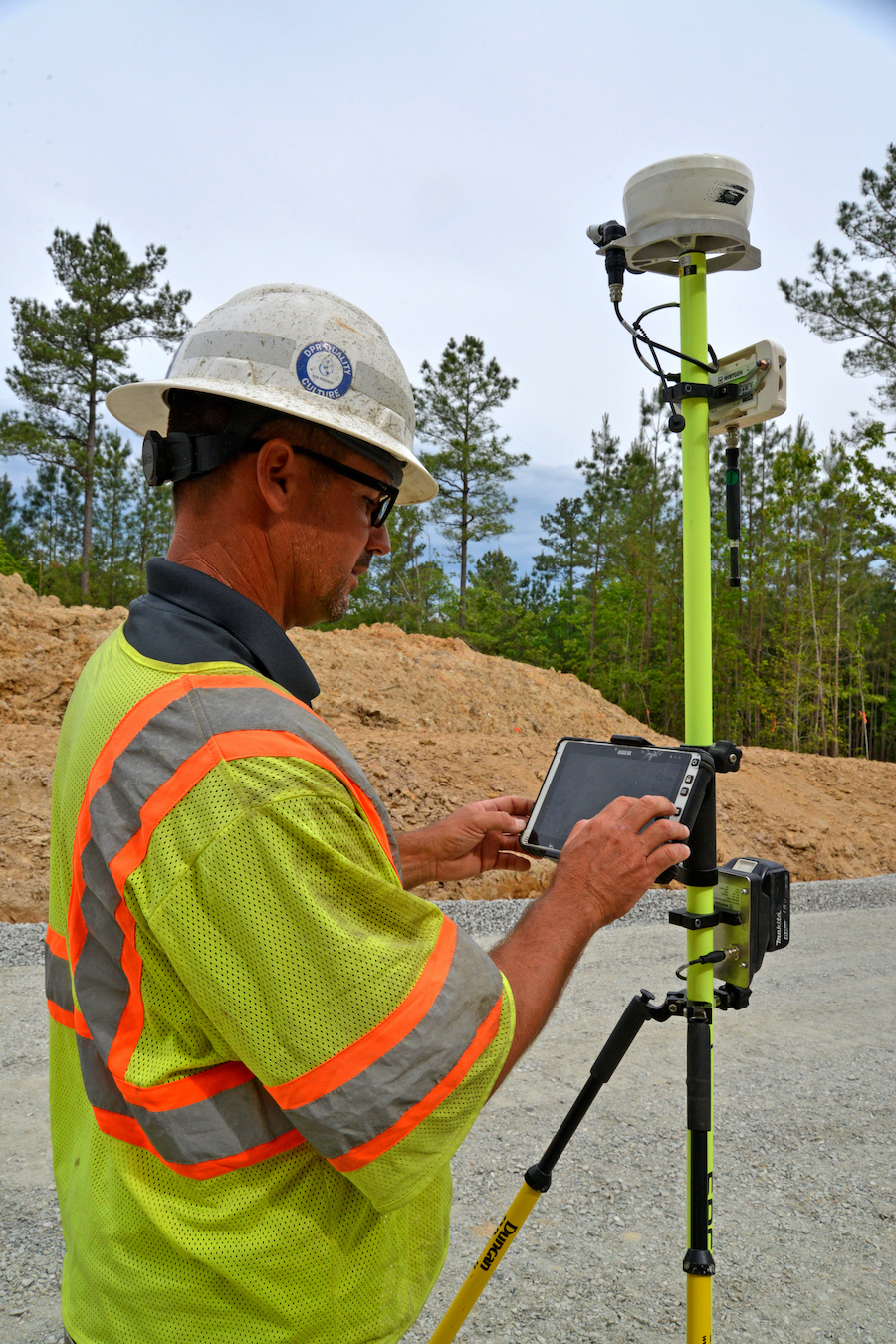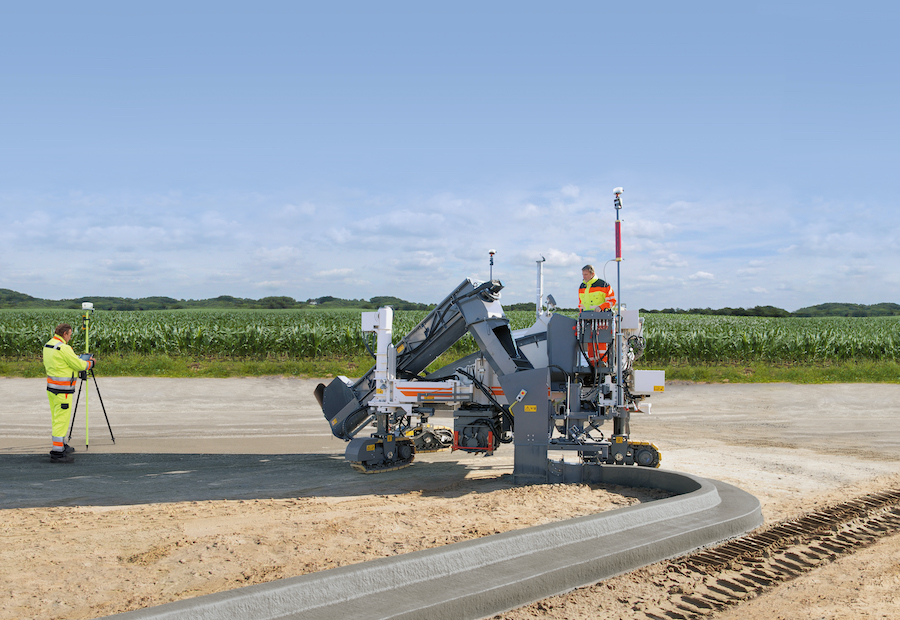
A concrete contractor from Virginia is one of the first companies in North America to upgrade to Wirtgen’s new AutoPilot 2.0 for stringless concrete paving.
Talley & Armstrong, Inc., based in Henrico, Virginia, had already equipped its Wirtgen slipform paver SP 15i with the first version of the AutoPilot, and relied on the system when using the machine. After the experienced users had the opportunity to experience the new AutoPilot 2.0 at the 2018 World of Concrete, they equipped the SP 15i with the new system.
The AutoPilot 2.0, which is compatible with Wirtgen’s SP 15i und SP 25i slipform pavers, eliminates the need to measure, mount, and remove stringlines. In addition, the ground crew can do their job without the stringlines constantly getting in the way. The 3D system is suitable for paving concrete safety barriers, curbs, gutter profiles, or traffic islands, for example, but also for road surfaces with a width of up to 3.5 m using the inset method and 2.5 m using the offset method
Stringless Paving Cuts Costs
Clay Armstrong believes in lean structures and operates the company’s SP 15i himself. In his eyes, stringless paving with the AutoPilot 2.0 system saves an enormous amount of time. “Stringless paving has many advantages,” explains Armstrong. “First of all, you eliminate all the work involved in setting up the stringlines. Another factor are the costs saved from no longer having to purchase the wire and the support arms.”
In addition, he says, the paving jobs are completed more quickly. “The first time we worked stringless, our job was to pave a curb/gutter profile in a parking lot. At the end of the first day of work, my employees would have normally had to take down the stringline and set it back up again for the section we were going to work on the following day. Instead, they just asked me what they should do. There were no stringlines to remove or set back up. That equals direct cost savings.
Armstrong continues: “In the case of composite radii or tangent sections where it is important that all the tangents are dead straight, the process saves an enormous amount of time. We can pave all of the radii much faster. If we aren’t working with an imported model, we may need to spend two hours in a cul-de-sac setting up the necessary stringlines. Instead, I can use the Field Rover to enter the appropriate data points and create a virtual stringline in just ten minutes.

Upgrade to AutoPilot 2.0
According to Clay Armstrong, the first AutoPilot system was already easy to use, but upgrading the SP 15i with the new system brings other major benefits. “The AutoPilot 2.0 system is much more user-friendly and the tablet we use both on the operator’s platform and with the Field Rover survey pole has a much better display. The system gives us the ability to make changes to the model regardless of whether it was imported or created from ground points or the usual stakes set up for curb/gutter profiles,” says Armstrong.
“Since civil engineers are also only human, we have to correct their models from time to time. We can change both the vertical and horizontal alignment during the paving process to compensate for any defects. Changes to the vertical curve were difficult or not at all possible with the previous version. In addition, we didn’t have the display we now have. We didn’t have a profile to make adjustments, as is now possible with AutoPilot 2.0. Now we can actually make numerous changes and even delete or add points to an existing model.”
Armstrong adds: “We can change individual points on a vertical curve and pull them apart as far as it takes to smooth a route. If we know, for example, that point A and point B are connected by a straight gradient, we can theoretically delete all of the intermediate points that don’t match, or return to the original model. And we can also change the percentage of the gradient in the model if we find that it’s incompatible with on-site conditions.”
The Field Rover is portable and Armstrong uses it during the paving process to inspect inlets. “We mainly use the Field Rover to modify the imported model to the job ahead using control points.” The smallest radius Armstrong has ever paved was 60 cm, which was no problem for the AutoPilot 2.0 system.
Ergonomic SP 15i
Thanks to the Wirtgen SP 15i, paving concrete profiles has also become much easier for Talley & Armstrong. A functional, ergonomically designed operator’s platform is one of the machine’s standout features. “Visibility is excellent,” says Armstrong. “You can see the funnel’s auger conveyor as well as the concrete being poured into the mold. And the concrete profile leaving the mold.”
Armstrong prefers the auger conveyor to the belt conveyor because it can store larger quantities of concrete. This is particularly important when paving radii, because interrupting the paving process has a negative effect on paving quality.
Talley & Armstrong has eight Wirtgen molds, ranging from a curb gutter profile 15 cm wide to a 1.50-meter-wide sidewalk mold. An adapter plate also makes it possible to attach the molds from an older paver to the SP 15i. This means that contractors can cost-effectively use molds from other suppliers as well.

Precise Paving of Curb with Rain Gutter
During a Talley & Armstrong project in Westerleigh Estates, a new residential development in Moseley, Virginia, the company used a 75-centimeter-wide curb/ gutter form that produced a rain gutter 60 centimeters wide in combination with a curb about 15 centimeters wide and 33 centimeters high. The relatively stiff concrete with a slump of 5 cm had a 28-day strength of 30-35 N/mm². Paving was carried out on a sub-base of gravel with a maximum grain size of 2.5 cm. The concrete mix contained a viscosity improver and a small amount of setting retarder in the event of delays in concrete delivery.
After paving was complete, a liquid curing agent was sprayed on and later contraction joints were cut into the curb at intervals of 3.50 meters and expansion joints at intervals of 30 meters.
About AutoPilot 2.0
The 3D control system includes a tablet that both controls the machine and is attached to the Field Rover survey pole. Two GPS receivers mounted on the machine communicate with a GPS reference station at the job site. The global navigation satellite system (GNSS) controls the steering and transverse tilt of the slipform paver fully automatically. In combination with an ultrasonic sensor or a robot-controlled total station, it also precisely controls the machine height.
Thanks to a certified standard interface, the SP 15i and SP 25i can be equipped not only with AutoPilot 2.0, but also with 3D systems from other leading suppliers. The data is transferred to the machine via a 3D interface. During paving, various systems such as the GNSS-based RTK receiver or automatic total stations are used.
Sensors on the machine take highly accurate readings during the paving process. These systems constantly compare the target and actual values of the paving parameters. If a digital three-dimensional terrain model is not available for a project, the Wirtgen Field Rover can be used to generate a new digital data model directly on site. Existing machines can easily be upgraded with AutoPilot 2.0.










































